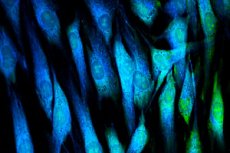Nye publikasjoner
Forskere har beskrevet hvordan celler aktiveres for å forårsake fibrose og arrdannelse i organer
Sist anmeldt: 02.07.2025

Alt iLive-innhold blir gjennomgått med medisin eller faktisk kontrollert for å sikre så mye faktuell nøyaktighet som mulig.
Vi har strenge retningslinjer for innkjøp og kun kobling til anerkjente medieområder, akademiske forskningsinstitusjoner og, når det er mulig, medisinsk peer-evaluerte studier. Merk at tallene i parenteser ([1], [2], etc.) er klikkbare koblinger til disse studiene.
Hvis du føler at noe av innholdet vårt er unøyaktig, utdatert eller ellers tvilsomt, velg det og trykk Ctrl + Enter.

En ny studie fra Unity Health Toronto, som undersøker hvordan fibroblastceller i kroppen aktiveres for å forårsake fibrose og arrdannelse i organer, ble publisert i tidsskriftet Nature Reviews Molecular Cell Biology. Fibrose og arrdannelse i organer er en ledende dødsårsak, med bevis som tyder på at de er ansvarlige for opptil 45 % av dødsfallene i utviklede land.
Fibrose er en prosess der fibroblastceller i kroppen vår produserer overskuddsmengder av et proteinkompleks kalt ekstracellulær matriks (ECM). ECM inneholder proteiner som kollagen, elastin og fibronektin, og kan betraktes som et slags kroppsomfattende «lim» som forbinder de ulike organene i kroppen vår og opprettholder grensene deres.
Normalt produserer fibroblaster ECM for å støtte vevsstrukturen og for å hjelpe til med å reparere skadet vev. For eksempel, under normale omstendigheter, når du får et kutt, flytter fibroblaster seg til kuttet eller såret, formerer seg og produserer ECM for å hjelpe til med å helbrede såret. Ved fibrose mottar imidlertid fibroblaster visse signaler som aktiverer dem til å overprodusere ECM.
Denne overskytende ECM-en, spesielt overskytende kollagen, kan føre til dannelse av arrvev, noe som kan svekke organfunksjonen. Fibrose kan forekomme i alle vev eller organer i kroppen, inkludert lunger, lever, nyrer og hjerte, og er forbundet med mange vanlige sykdommer, ofte i sene stadier.
En ny studie oppsummerer noen av signalene og molekylære mekanismene som spiller en rolle i å aktivere fibroblaster til å overprodusere ECM. Forskerne diskuterer også heterogeniteten til fibroblaster og hvordan deres større heterogenitet kan påvirke helbredelsesprosessen.
«Denne gjennomgangen forsøker å avdekke noe av vår kunnskap og forståelse – eller misforståelse – av fibroblaster og deres aktivering», sa dr. Boris Hinz, studieforfatter og forsker ved Keenan Centre for Biomedical Science ved St. Michael's Hospital.
«Vi snakker vanligvis om fibroblaster som aktiveres fra en sovende tilstand under normal heling og fibrose. Men cellene som ble aktivert for å lage ny ECM var ikke virkelig sovende, og ikke alle av dem var fibroblaster», sa Hinz. «Vi ønsket å forstå nøyaktig hvilke celler som ble aktivert. Hvilke typer aktiveringer skjedde – som: 'Hva er de viktigste signalene som aktiverer disse fibroblastene, og hvordan?'»

Nukleær mekanotransduksjon og myofibroblasthukommelse. Kilde: Nature Reviews Molecular Cell Biology (2024). DOI: 10.1038/s41580-024-00716-0
Fibroblaster forblir «på» Doktorgradsstudent Fereshteh Sadat Younesi bidro til å gjennomføre studiet. Younesi er medlem av Hintz-laboratoriet og student ved St. Michael's Research Training Center.
"Et av hovedsignalene kommer fra mekanisk stress i det kompakte miljøet i fibrotiske områder. Når vev gjennomgår fibrose, blir de mye stivere enn normalt på grunn av disse fibroblastene som begynner å overprodusere og omorganisere ECM," sa Younesi.
"Disse fibroblastene kjenner stivheten rundt seg, noe som holder dem 'på' selv etter at den første skaden har grodd. Disse mekanisk induserte fibroblastene forverrer det fibrotiske området med sin konstante aktivitet."
Hinz sa at når forskere bedre forstår signalene og mekanismene som er involvert i fibroblastaktivering, kan de kanskje utvikle terapier og intervensjoner for å avbryte denne prosessen og stoppe overproduksjonen av ECM, og dermed stoppe fibrose.
«Vi trenger en måte å kurere fibrose på. Forskere har visst om fibrose i omtrent et århundre, og det finnes fortsatt ingen kur», sa Hinz. «Med bare to legemidler som er godkjent for øyeblikket, kan vi stoppe fibrose i noen organer – i beste fall. Det endelige målet ville være å «instruere» de arrdannende cellene til å fjerne overflødig ECM med farmasøytisk veiledning. Det er dit vitenskapen er på vei, og det er den ultimate drømmen.»
